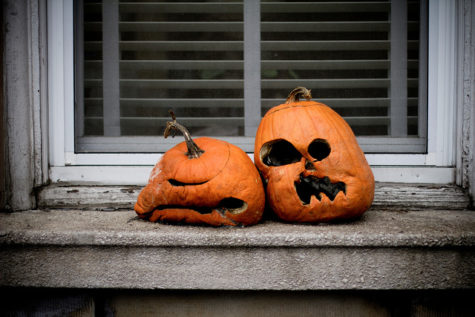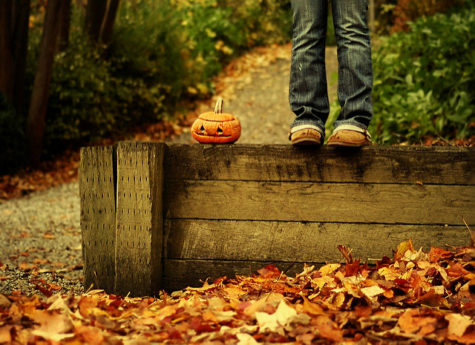 On Sunday we sat outside on the sidewalk and carved our pumpkins. As we worked, we reminisced about past pumpkin carving sessions. My mom and my brother and I used to carve them on the kitchen floor, on the rectangle squares of linoleum. My husband and his sister used to carve their pumpkins in the living room on a protective barrier of newspapers. Both the houses we carved in are now gone, but the memory of the pumpkins links us to those places and those moments.
On Sunday we sat outside on the sidewalk and carved our pumpkins. As we worked, we reminisced about past pumpkin carving sessions. My mom and my brother and I used to carve them on the kitchen floor, on the rectangle squares of linoleum. My husband and his sister used to carve their pumpkins in the living room on a protective barrier of newspapers. Both the houses we carved in are now gone, but the memory of the pumpkins links us to those places and those moments.
Pumpkin carving is one of the few holiday traditions I’ve kept almost every year. I carved pumpkins in college towns, ski towns, and in the absence of a pumpkin abroad, made do with a different squash. I carved them with a group of jaded twenty-somethings who, in the presence of pumpkins and knives, suddenly became giddy with delight. Now I carve them with my kids, and I take special pleasure in putting candles in them, something we were never allowed to do growing up.
This weekend we were talking about how much easier it is to carve now, with the little tools that help you saw away with more precision and less danger than the steak knives we used to use. We remembered the architect who lived across the street, whose pumpkins were legendary for their creativity, even before there were pumpkin templates on Pinterest to follow.
Another thing that seems to be different is the timing. I remember as a kid carving pumpkins a week before Halloween. Over the years—and this is my unscientific observation—we seem to be carving them closer and closer to Halloween. Otherwise they begin to rot too soon, their faces crumpling inward, their toothy grins suddenly in need of dentures.
This is the farthest south I’ve ever carved pumpkins, and October tends to be when we get our heat wave, so the local weather might have something to do with it. Maybe our technique is off. (Should we have been using an explosion instead of diligently nudging out the eyes with a spoon?). Maybe my memory is just bad—the near-infinite wait between the carving session and Halloween night seemed infinite could have just been excitement for the orangest day of the year to arrive.
Phenology is the study of natural phenomena that happen seasonally—the timing of the first blossom, the arrival of migratory birds. Records like these, kept over the years, can help us learn about the climate of the past. Researchers have found these seasonal patterns are shifting as the climate warms, which alters the relationships among species. These changes affect us, too; seasonal signals help people know when to plant crops and to refill their allergy medications.
 There are also all the markers of our own personal seasons. If it’s light enough to take a walk in the morning, we must have made it past Valentine’s Day. The persimmon tree starts to leaf in March. Spring is the season of losing shoes and playing games on the sidewalk with neighbors, who it seems like we haven’t seen since October. Sometimes, too, we plant pumpkins.
There are also all the markers of our own personal seasons. If it’s light enough to take a walk in the morning, we must have made it past Valentine’s Day. The persimmon tree starts to leaf in March. Spring is the season of losing shoes and playing games on the sidewalk with neighbors, who it seems like we haven’t seen since October. Sometimes, too, we plant pumpkins.
Summer comes, the season of new swimsuits and popsicles. The giant flag comes out of the attic. The camping gear gets dusted off. And then the pumpkins start growing.
By August, the persimmon has small green fruit when the kids take a picture in front of it on the first day of school. September is the time to have tea in the afternoon and candles at dinner. Soon enough, it’s time to pick the pumpkins. But not too soon. Shifts in these regular rhythms of our lives can sometimes happen so slowly that they go unnoticed. And sometimes it takes years to notice that the signal is gone.
Apparently, there are ways to protect a carved pumpkin from early collapse. Some recommend rubbing the inside of the pumpkin with bleach to prevent mold; others suggest Vaseline or vinegar. If they start getting saggy too soon, they can get an overnight ice bath to plump out their cheeks again.
But by giving it a face, you’ve already created a window for the air to come in, for the moisture to fly out. Now there is a passageway for fungi and bugs to come and feast on the open fruit. Uncarved pumpkins last longer—maybe even for six months—but eventually, they’ll cave, too.
So we carve when we can, because we can. We put a face on the changing seasons and light it up with a candle. Rot is inevitable. But radiance is welcome, too.
*
Images by Michael and Emergency Brake via Flickr/Creative Commons